Recent advances in two-step energy transfer light-harvesting systems driven by non-covalent self-assembly✩
Zhiying Wu ,Hongwei Qin ,Xiuxiu Li ,Tngxin Xio,∗ ,Leyong Wng
a Jiangsu Key Laboratory of Advanced Catalytic Materials and Technology,School of Petrochemical Engineering,Changzhou University,Changzhou 213164,China
b Key Laboratory of Mesoscopic Chemistry of MOE,School of Chemistry and Chemical Engineering,Nanjing University,Nanjing 210023,China
Keywords: Light-harvesting system Supramolecular self-assembly Sequential energy transfer Tunable fluorescence FRET
ABSTRACT Sequential energy transfer is ubiquitous in natural light-harvesting systems (LHSs),which greatly promotes the exploitation of light energy.The LHSs in nature are sophisticated supramolecular assemblies of chlorophyll molecules that carry out efficient light harvesting through cascade energy transfer process.Inspired by nature,scientists have paid much attention to fabricate stepwise LHSs based on assorted supramolecular scaffolds in recent years.Light-harvesting antennas and energy acceptors can be accommodated in particular scaffolds,which offer great convenience for energy transfer between them.These systems not only further mimic photosynthesis,but also demonstrate many potential applications,such as photocatalysis,tunable luminescence,and information encryption, etc.In this review article,aiming at offering a practical guide to this emerging research field,the introduction of construction strategies towards sequential LHSs will be presented.Different scaffolds are classified and highlighted,including host-guest assemblies,metal-coordination assemblies,as well as bio-macromolecular and other supramolecular scaffolds.
1.Introduction
Natural photosynthesis is extremely important for all living things on the Earth.The initial process of photosynthesis is the absorption of solar energy through abundant antenna pigments.The excitation energy passes through several steps of energy transfer and finally reaches the reaction center [1–3].The light-harvesting systems (LHSs) found in nature show well-organized supramolecular architecture that consists of chlorophyll molecules and protein scaffolds [4].To mimic the natural photosynthesis,a diverse set of artificial LHSs have been constructed through supramolecular selfassembly [5,6].For example,in 2014,Penget al.constructed an artificial LHS based on hydrogen bonded supramolecular polymers[7].In 2015,Menget al.reported an efficient LHS based on a pillar[5]arene dimer host and BODIPY guests [8].In 2017,Liet al.fabricated a supramolecular one-step LHS with an ultrahigh antenna effect through cyclodextrin-based host-guest interaction [9].In 2019,we summarized the artificial LHSs assembled by macrocyclic host-guest interactions [10].However,most of these artificial LHSs are only one-step energy transfer,while sequential multi-step energy transfer is ubiquitous in natural LHSs.In this context,over the past three years,scientists have begun building supramolecular LHSs based on sequential two-step energy transfer.The advantages of artificial sequential LHSs are as follows: (1) the system can better mimic the multi-step energy transfer process in nature;(2) such systems have larger Stokes shift;(3) these systems usually show tunable fluorescence in a broad-spectrum area;(4) these systems are often very efficient due to the energy transfer cascade.
A two-step LHS usually consists of a kind of energy donor and two kinds of energy acceptors,the relay acceptor (first acceptor) and the final acceptor (second acceptor).The donor chromophores act as a light-harvesting antenna,capturing the excitation energy and transferring it to the final acceptorviathe relay acceptor.These donor and acceptor dyes should be co-assembled in close proximity within special supramolecular scaffolds,allowing efficient Förster resonance energy transfer (FRET) between them.The sequential energy transfer results in larger Stokes shifts and a broad emission color regulation.To achieve highly effi-cient light harvesting process,aggregation-induced emission (AIE)[11–15] fluorophores are often used as energy donors owing to their outstanding photophysical properties in the assembled state[16].Energy-acceptor dyes with matched absorption and emission wavelength are preferrably selected.It means that the emission spectrum of the donor and the absorption band of the relay acceptor,as well as the emission spectrum of the relay acceptor and the absorption band of the final acceptor should have considerable overlapping areas.Fig.1 shows the absorption and emission maxima of the most common acceptors used for constructing sequential LHSs.

Fig.1.Energy acceptors used for fabricating sequential LHSs.
The supramolecular scaffolds can be driven by different kinds of non-covalent interactions,such as multiple hydrogen bonding,π πinteraction,host-guest interaction,metal coordination,and hydrophobic interaction.As a result,various scaffolds have been created to accommodate the donors and acceptors,including hostguest nanoparticles,metallacycles/stacks,biomacromolecules and supramolecular polymers.In this mini-review,we will summarize these elegant supramolecular LHSs with two-step sequential energy transfer that reported in the last three years.
2.Sequential LHSs based on host-guest assemblies
Macrocycle-based host-guest interactions are usually employed to drive the formation of assorted supramolecular assemblies [17–24].In recent years,scientists fabricated a variety of artificial LHSs based on macrocycles [10,25].Previously,scientists focused on the construction of one-step energy transfer LHSs based on crown ethers [26,27],cyclodextrins [9,28–30],pillar[n]arenes [8,31–42],calix[n]arenes [43–46] and cucurbit[n]urils [47–51].In recent three years,a series of two-step energy transfer LHSs has been constructed by using pillar[n]arenes and cucurbit[n]urils.Therefore,in this part,we will highlight these two-step LHSs.
2.1.Sequential LHSs fabricated by pillar[n]arene
Pillar[n]arenes are macrocycles composed of dialkoxybenzene units linked by methylene bridges atpara-positions.The symmetrical pillar architecture and easy derivatization of pillar[5]arenes allow them to complex with various guests [52–54].Recently,several two-step LHSs based on pillar[n]arenes are reported.In 2020,Haoet al.published a work on pillar[5]arene-mediated LHS with two-step FRET [55].As shown in Fig.2,they first synthesized a tetraphenylethylene (TPE) derived bola-type guest molecule TPEDA,which can bind with a water-soluble pillar[5]arene (WP5)through host-guest interaction.The host-guest amphiphile further self-assembled into nano-aggregates in water.Dynamic light scattering (DLS) data of the nanoparticles exhibited a narrow distribution with diameter of about 180 nm and transmission electron microscope (TEM) image showed a spherical shape,indicating a multilayer vesicular architecture.Since TPE is a typical AIE group,the fluorescence intensity of the nanoparticles was greatly enhanced,suggesting that the WP5-TPEDA assembly can serve as an ideal energy donor for the fabrication of an artificial LHS.Subsequently,hydrophobic dyes Eosin Y (ESY) and Nile Red (NiR) were successively loaded into the WP5-TPEDA nanoparticles to form a two-step energy transfer LHS owing to their appropriate photophysical properties.The light-harvesting and energy-transfer performance of the LHS were evaluated by both steady-state and transient fluorescence spectroscopy.Notably,the system could display a strong whitelight emission when TPEDA/ESY/NiR=100:5:2.The energy-transfer efficiency of the first step was calculated to be 92.45%,while the second step was 74.78%,suggesting the successful fabrication of a sequential energy transfer LHS.Finally,the authors employed this LHS system as a photocatalyst to catalyze dehalogenation reaction.Compared to the low yield (31%) catalyzed by ESY+NiR alone,dehalogenation ofα-bromoacetophenone in water achieved a good yield of 96%.This is a great example of converting light energy into chemical energy,reminiscent of photosynthesis in nature.
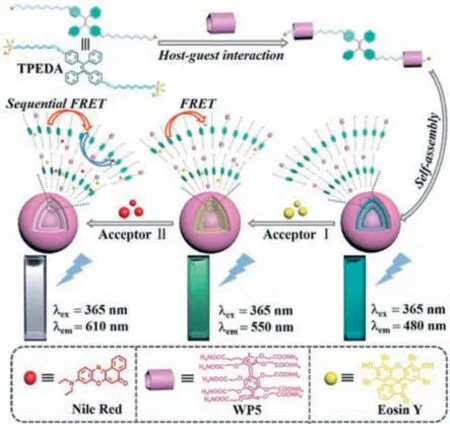
Fig.2.Illustration of the self-assembly of pillar[5]arene-based aqueous LHS with two-step FRET.Reproduced with permission [55].Copyright 2020,Wiley Publishers.
Considering the above system showed a moderate antenna effect for both energy transfer steps,in a follow-up investigation,Sunet al.further built a new two-step LHS with higher antenna effect by changing the TPE group in the bola-type guest to an AIEactive cyanostilbene group to afford a new guest molecule BPT (Fig.3) [56].In this system,4,7-bis(thien-2-yl)-2,1,3-benzothiadiazole(DBT) acts as the relay acceptor and NiR serves as the final acceptor.The authors first investigated the host-guest complexation and then studied the morphology of the formed nano-aggregates.The fluorescence lifetime of WP5-BPT was fitted as a double exponential decay and decreased fromτ1=0.60 ns andτ2=2.80 ns toτ1=0.40 ns andτ2=2.42 ns when co-assembled with DBT and monitored at 450 nm.The fluorescence lifetime of WP5-BPT-DBT further decreased fromτ1=1.36 ns andτ2=2.82 ns toτ1=1.11 ns andτ2=2.38 ns when co-assembled with NiR and monitored at 550 nm.Notably,this system showed an ultrahigh antenna effect of 47.8 (BPT/DBT=350:1) for the first step energy transfer and 20.1(BPT/DBT/NiR=350:1:1) for the second step energy transfer.This work demonstrated that cyanostilbene group could act as an ideal antenna and energy donor in pillar[n]arene-based LHSs to afford ultrahigh antenna effect.Very recently,Tianet al.further built a ternary supramolecular photosensitizer based on a two-step FRET process by an AIE-active pillar[5]arene host,a spiropyran derivative guest,and a Nile blue (NiB) dye in water [57].This photoswitchable system with tunable reactive oxygen species (ROS)-generation ability can be used to inactivation of bacteria and cancer cells.
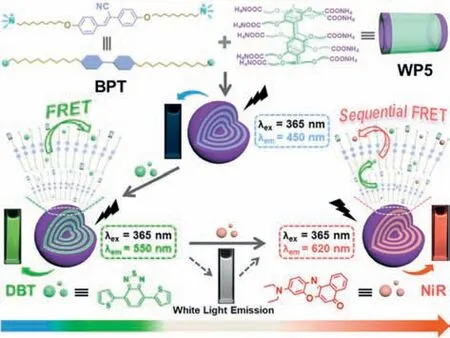
Fig.3.Cartoon representation of the construction of sequential two-step LHS based on WP5,BPT,DBT,and NiR.Reproduced with permission [56].Copyright 2020,the Royal Society of Chemistry.
In 2020,Zhang and Liuet al.reported a sequential energy transfer LHS based on WP5 and a TPE-derived guest [58].In this case,the authors employed sulforhodamine 101 (SR101) as the bridge acceptor and sulfonated aluminum phthalocyanine (AlPcS4) as the second acceptor.As the excitation energy transferred from the donor to SR101 and then to AlPcS4,the emission color changed from blue to near infrared (NIR),leading to a Stokes shift up to 340 nm.In 2022,Han and Xinget al.also disclosed a two-step LHS based on WP5 and a cyano-substitutedp-phenylenevinylene derivative (PPTA) [59].PPTA plays the roles of both a bola-type guest and an energy donor.The PPTA-WP5 host-guest complex can self-assemble into nanoparticles.By loading ESY and NiR as acceptors into the nanoparticles,a sequential energy transfer system could be realized.To make full use of the collected energy,this LHS was successfully used as a photocatalyst to promote the aerobic cross-dehydrogenative coupling reaction in aqueous solution.It is worth mentioning that they also employed PPTA to construct a sequential LHS with a bis-calixarene host [60].
Inspired by the bola-type guest based on TPE as discussed above [55],we further synthesized a new tadpole-type moleculeGbased on TPE with pyridinium moiety as the guest-binding site and employed it to reconstitute a highly efficient sequential LHS with WP5 [61].WP5 can significantly reduce the critical aggregation concentration (CAC) ofGfrom 131 μmol/L to 12 μmol/L according to transmittance measurements,greatly enhancing AIE effect ofG.As shown in Fig.4,fluorescent dye ESY was employed as the relay acceptor and another hydrophobic dye NiR was used as the final acceptor to sequentially harvest the excitation energy from WP5⊃Gnanoparticles.As a consequence of the flexibility of the system,it shows tunable photoluminescence including a bright white-light emission,which was used for the preparation of whitelight emission LED device.Furthermore,the system was also used as a photocatalyst to catalyze dehalogenation reaction in water,showing outstanding catalytic activity in contrast to the WP5⊃Gor ESY/NiR alone.This research not only creates a unique approach for the construction of two-step LHSs,but also shows great potentials in white-light emission device and photocatalytic reactions.Very recently,we further fabricated a two-step LHSs based on WP5,a bola-type guest,ESY,and SR101 [62].
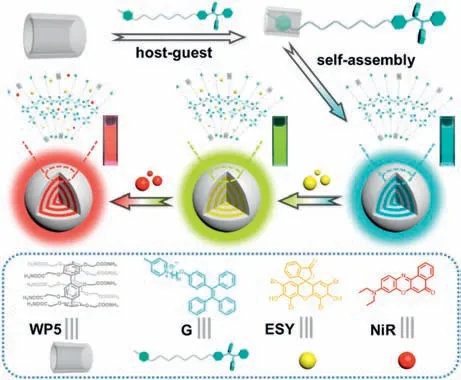
Fig.4.Cartoon representation of the construction of a sequential energy-transfer LHS and the chemical structures of WP5, G,ESY and NiR.Reproduced with permission [61].Copyright 2023,Elsevier Publishers.
New types of scaffolds have continuously explored for constructing highly efficient artificial LHSs.Conjugated structures are very suitable as scaffolds because they exhibit good molecular wire effects,which can facilitate energy transfer between chromophores.However,the ACQ effect caused by the planarity of the conjugated structure needs to be suppressed.In this context,Xuet al.designed and synthesized an assembly-induced-emission orthogonal supramolecular network (AOSN) as a new type of artificial LHS (Fig.5) [63].The AOSN was fabricated by a tetratopic conjugated host (H) bearing 4 pillar[5]arene units and a spirobifluorene core and a ditopic guest (GG) bearing a TPE group.Efficient sequential energy transfer from H to GG and then to GY is achieved by introducing a ditopic conjugated guest (GY) into the scaffold.The antenna effect is greater than 60 over a wide range of H/GG/GY ratios.The high performance of the system should be due to several synergistic reasons: the formation of host-guest supramolecular polymer,the spirobifluorene units,the molecular wire effect,and the perfect overlap between donor’s emission and acceptor’s absorbance.
2.2.Sequential LHSs fabricated by cucurbit[ n]uril
Cucurbit[n]urils (CB[n]s) are pumpkin-like macrocyclic host,which exhibits outstanding host-guest behavior in water.CB[n]s have a rigid hydrophobic cavity and polar carbonyl groups at both portals.CB[6] and CB[7] can bind to one guest,while CB[8] can bind to two guest molecules simultaneously.In 2022,Wanget al.reported a highly efficient artificial LHS with a two-step energy transfer process based on host-guest interactions between CB[7]and cyano-substitutedp-phenylenevinylene derivative (PPTA) (Fig.6) [64].The host-guest complex CB[7]-PPTA was used as an energy donor.Two fluorescent dyes ESY and SR101 were employed as energy acceptors.The energy-transfer efficiencies in this twostep LHS were demonstrated as 38% and 33%,respectively.They further used this LHS as a photocatalyst for the dehalogenation of 2–bromo-1-phenylethanone,showing a yield of up to 86% in aqueous solution.
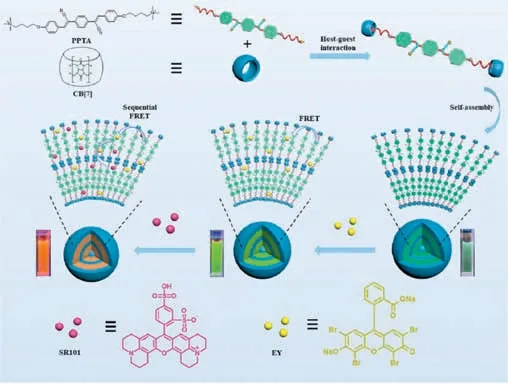
Fig.6.Schematic representation of self-assembly based on PPTA-CB[7] and the construction of a two-step LHS.Reproduced with permission [64].Copyright 2022,Elsevier Publishers.
In a follow-up work reported in 2023,Wanget al.constructed a two-step LHS based on supramolecular organic frameworks (SOF)[65].The SOF is self-assembled from a CB[8] host and two TPEderived guests: NA-TPE with four methoxynaphthyl (NA) groups and MV-TPE with four methylated viologens (MV) groups (Fig.7).The NA group and MV group can be simultaneously encapsulated into the cavity of CB[8],thus forming a SOF network.The SOF material has a strong cyan fluorescence in solution due to the AIE property of the guests,which provides a great opportunity for fabricating LHS by employing the SOF as an energy donor.Subsequently,they chose DBT as the first energy acceptor and SR101 as the second energy acceptor according to their outstanding photophysical properties.When 1% DBT is accommodated,the energy transfer efficiency from the SOF to DBT was calculated to be 70.2%.Moreover,the second step energy transfer efficiency from DBT to SR101 was determined to be 44.5% when the molar ratio of SOF:DBT:SR101=300:3:20.It is noteworthy that a white light emission was achieved in the SOF-SR101 binary system.Finally,the authors successfully applied such SOF-based two-step LHS to catalyze cross-dehydrogenative coupling (CDC) reaction ofN-phenyl tetrahydroisoquinoline and indole.The yield reached up to 87% in the presence of 0.45 mol% catalyst,demonstrating a great potential of two-step LHSs in the promotion of the CDC reaction.
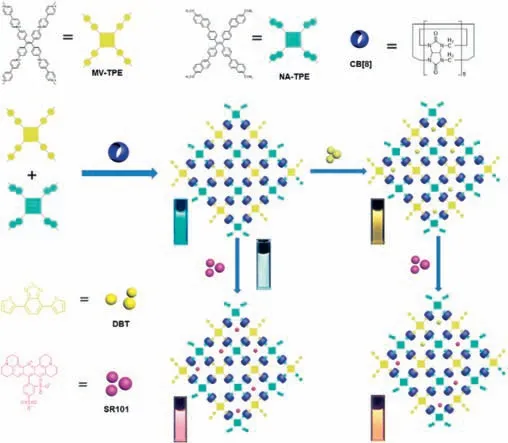
Fig.7.Illustration of the SOF-based LHS constructed from MV-TPE,NA-TPE,and CB[8].Reproduced with permission [65].Copyright 2023,the Royal Society of Chemistry.
Twisted CB[14] is another type of cucurbituril that possesses a unique structure with two cavities to form stable host-guest complexes.In 2022,Zhanget al.from Guizhou University fabricated a two-step sequential LHS based on twisted CB[14] for manufacturing white-light emission materials (Fig.8) [66].They synthesized a ditopic imidazole derivative (DIm),which can form linear supramolecular polymer with twisted CB[14] through host-guest interaction.In this case,the CB[14]-DIm host-guest complex was used as energy donor due to its good AIE behavior,and they further chose ESY as the first energy acceptor and NiR as the second energy acceptor.The energy transfer processes were characterized by both steady-state and transient fluorescence experiments.Notably,a bright white-light emission was successfully realized by adjusting the donor/acceptor ratio.They finally applied this whitelight emission material to produce white LED device.
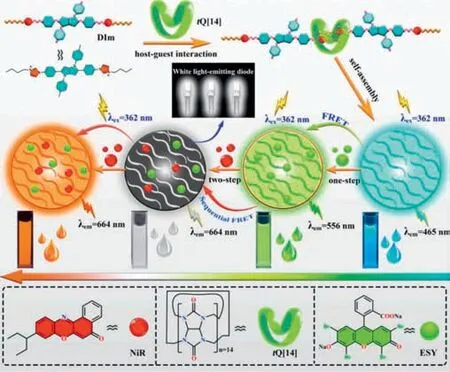
Fig.8.Representation of the self-assembly of DIm@tQ[14]-based aqueous LHSs.Reproduced with permission [66].Copyright 2022,Elsevier Publishers.
Room-temperature phosphorescence (RTP) of purely organic materials has attracted a lot of interests owing to its unique features of long-lived luminescence.In contrast to fluorescencebased FRET,the phosphorescence-based ones enable the acceptor dyes with a longer lifetime through a triplet to singlet FRET.In 2021,Huoet al.reported the first example of phosphorescencebased sequential LHS featuring delayed near infrared (NIR) emission through a multivalent self-assembly strategy based on macrocylic hosts of CB[7] and sulfonatocalix[4]arene (SC4AD) derivative(Fig.9) [67].The guest (G1) was complexed with CB[7] accompanied by the generation of a weak RTP emission at 505 nm.The obtainedG1-CB[7] complexes further assembled with SC4AD to produce a higher level complexG1-CB[7]@SC4AD,which are spherical nanoparticles and exhibit intense phosphorescence with 40-fold enhancement compared toG1-CB[7].Notably,the phosphorescence lifetime was determined to be 1.13 ms,which wasca.52.4 times than that ofG1-CB[7].The authors then employed theG1-CB[7]@SC4AD nanoparticles as an excellent scaffold to build sequential phosphorescence LHS with long-lived and long-range emission.RhB and DBT were employed as acceptors (acceptor I)for first-step FRET,while NIR organic dyes NiB and Cy5 were employed as acceptors (acceptor II) for second-step FRET.All these processes exhibit high energy transfer efficiency and anttenna effect.The cascaded LHS with long-range and delayed fluorescence(DF) was further successfully used for multicolour cell labeling.In a follow-up work,they further developed an ultralarge Stokes shift phosphorescence LHS by employing CB[8] and SC4AD [68].
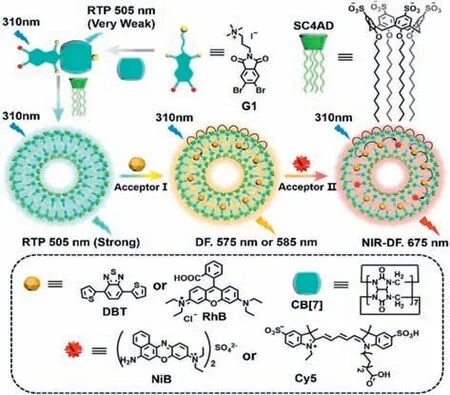
Fig.9.Illustration of the multivalent supramolecular assemblies based on CB[7]and SC4AD for purely organic RTP-based LHS in aqueous solution.Reproduced with permission [67].Copyright 2021,Wiley Publishers.
3.Sequential LHSs based on metal-coordination assemblies
Metal-coordination self-assembly provides a convenient way for the fabrication of various coordinated complexes,ranging from metallacycles/metallacages to networks/frameworks.Back in 2005,Sautterret al.pioneered the construction of an artificial light-harvesting assembly based on a metal-coordinated molecular square [69].In the past decade,a variety of one-step energy transfer LHSs based on metal-coordination have been reported by employing AIE fluorophores as energy donors [70–74].Notably,the combination of metal coordination and other non-covalent interactions,such as host-guest interaction orπ-πstacking interaction,further provides opportunities for constructing special lightharvesting scaffoldsviahierarchical self-assembly.In recent three years,supramolecular chemists have begun fabricating two-step energy transfer LHSs based on metal-coordination self-assembly and hierarchical self-assembly,which will be highlighted in this section.
In 2021,Zhang and Yiet al.reported an efficient LHS based on metallacycle with two-step energy transfer for photochemical catalysis [75].As shown in Fig.10,they first synthesized a TPE-derived ligand compoundL1,which can self-assemble into a quadrilateral metallacycle (M1) with platinum (II).On account of the AIE behavior,M1is an outstanding energy donor in LHS.ESY could be incorporated into the hydrophobic core ofM1and served as the relay acceptor of the LHS.M1can further self-assemble into nanospheres in H2O–CH3OH (19:1,v/v) solvent,which were characterized by TEM and DLS.By loading SR101 as the second acceptor,two-step sequential energy transfer process could be achieved fromM1metallacycle to SR101 through ESY.The sequential energy transfer process can not only use UV light but also utilize visible light to activate dyes,leading to an enhanced photocatalytic activity ofM1.Therefore,the authors used the LHS as a photocatalyst to catalyze the alkylation of C–H bonds in water,which showed an efficient conversion and good yield.This case demonstrated that the system can take full advantage of the harvested solar energy to catalyze the photochemical reaction in aqueous solution.In a next work,they further built a two-step LHS for information dual encryption and anticounterfeiting [76].
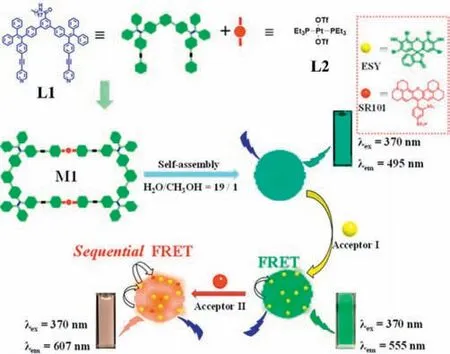
Fig.10.Self-assembly of metallacycle M1 and illustration of the construction of the metallacycle-based LHS.Reproduced with permission [75].Copyright 2021,American Chemical Society.
By employing an orthogonal self-assembly strategy,Jiaet al.constructed a sequential LHS through platinum(II)-based metal coordination and pillar[5]arene-based host-guest interactions [77].In their system,specific numbers of BODIPY,coumarin,and anthracene fluorophores at precise distances were well organized in the scaffolds.As a result,the photosensitization efficiency and photooxidation ability of the system were gradually enhanced with the number of FRET steps.In another work,Lu,Hai,and Wanget al.employed Zn(II) coordination and pillar[5]arene-based host-guest interactions to fabricate a two-step LHS with near-infrared (NIR)emission [78].In this system,MAPbBr3quantum dots were used as energy donor and two different fluorescent dyes ESY and Nile blue were utilized as energy acceptors.The obtained material could be used for near infrared (NIR) fluorescent imaging of the sweat pores of latent fingerprints (LFP),opening a new window to design NIR emitting LHSs for third-level LFP imaging.
In 2022,Acharyyaet al.employed emissive platinum(II) macrocycles as tunable scaffolds for the fabrication of a cascade energy transfer system [79].The macrocycle was formed by the selfassembly of a ditopic ligand and a diplatinum(II) monomer.The ligand contains a triphenylamine core and a cyanostilbene group with a long alkyl chain.Cyanostilbene groups exhibits good AIE behavior,making the macrocycle a good energy donor (Fig.11).Moreover,the authors dispersed these macrocycles in water/acetone mixture to obtain AIE-enhanced nanoparticles.The morphologies of the nanoparticles were characterized by SEM,TEM,and DLS,indicative of the formation of spherical particles with diameters about 200 nm.Subsequently,they employed two fluorescent dyes ESY and NiR as the first and second energy acceptors,respectively,to build a two-step sequential LHS.The cascade energy transfer processes were verified by fluorescence spectra and fluorescence lifetime measurements.Interestingly,the energy transfer efficiency was dependent on the alkyl chain length of the ligand.This is because longer hydrophobic chains promote better aggregation and light-harvesting properties in self-assembled nanostructures.These experimental findings have the potential to be used for fabricating desirable LHSs with high energy transfer efficiency for diverse applications in the future.In a follow-up work,they further reported a similar two-step LHS based on supramolecular coordination polymers,which were formed by two-component coordination-driven self-assembly of atrans-[Pt-(PEt3)2(OTf)2] acceptor with a tetraimidazole donor containing TPE core [80].
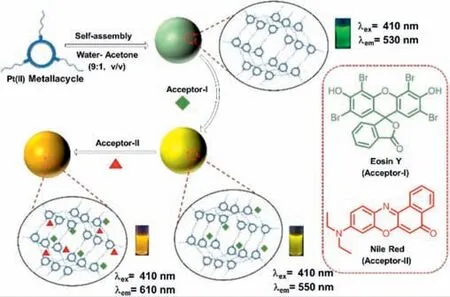
Fig.11.Cartoon representation of the macrocycle-based LHS with two-step sequential energy transfer.Reproduced with permission [79].Copyright 2022,Wiley Publishers.
In most of the photosynthetic organisms,the rigid protein scaffolds serve as key elements to bind pigments and control their excitation energy transfer.However,the overall energy transfer efficiency (Φoverall) of the most man-made LHSs is less than 70%,which is much lower than that of purple photosynthetic bacteria(almost 100%).This is likely due to the disordered donor/acceptor(D/A) organization in these scaffold-supported artificial systems.Inspired by the densely packed bacterialchlorophyll (BChl) pigments in green photosynthetic bacteria,in which excitation energy efficiently transfers from the BChlcantenna through BChlain the baseplate of a chlorosome,and ultimately to the reaction center,Wanget al.from University of Science and Technology of China fabricated a two-step LHS with a highΦoverallvalue throughπ-stacking of three differentσ-platinated (hetero)acenes [81,82].As shown in Fig.12,theseσ-platinated (hetero)acene monomers can undergo supramolecular polymerizationvia π-stacking in apolar solvent due to their strong intermolecular packing tendency.The introduction of two amide groups into the three monomers can further enhance the non-covalent packing strength through hydrogen bonding.Notably,the large Pt(II) groups allow suffi-cient space between the monomers,avoiding aggregation-caused quenching and maintaining sufficient emission intensity.Given that their structural similarity,these donor and acceptor monomers can aggregate with each other to form supramolecular copolymers,guaranteeing D/A energy transfer capability.As a result,they show long diffusion length of excitation energy and high exciton migration rates,which gives rise to a very highΦoverallof 87.4%.This study takes advantage of well-established supramolecular principles to enable ordered structure on the nanoscale,leading to highly efficient energy transfer behavior.The approach described in this work will be greatly beneficial for the development of highefficient LHS.
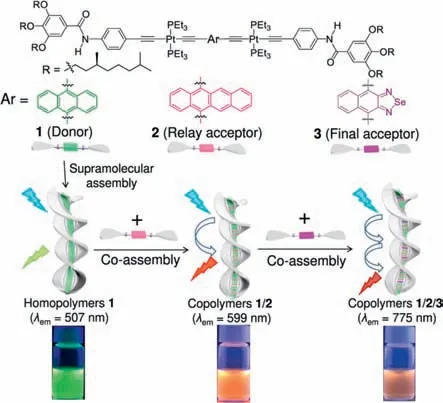
Fig.12.Cartoon representation of the supramolecular copolymerization of 1,2,and 3 with sequential energy transfer behavior.Reproduced with permission [82].Copyright 2022,Nature Publishing Group.
4.Sequential LHSs based on bio-macromolecular assemblies
In natural photosynthetic system,light-harvesting chromophores are tightly wrapped around the surrounding protein scaffold,allowing solar energy to be absorbed and transferred from the donor to the acceptor and eventually to the reaction center.Inspired by this,scientists attempted to construct artificial LHS by employing bio-macromolecular scaffolds,such as proteins and DNA [83–85].In 2021,Perrieret al.constructed an efficient LHS based on self-assembled cyclic-peptide (CP) nanotubes in water[86].They designed and synthesized 3 fluorophore attached CP conjugates with poly(ethylene glycol) (PEG) tails: pyrene-CP-PEG(PYR-CP-PEG),naphthalene monoimide-CP-PEG (NTI-CP-PEG),and cyanine3-CP-PEG (Cy3-CP-PEG).Efficient energy transfer could take place from PYR-CP-PEG to NTI-CP-PEG,and subsequently to Cy3-CP-PEG when co-assembling these three monomers into supramolecular peptide nanotubes in water.Interestingly,the typical ACQ effect was largely suppressed owing to the slipped stacking arrangement of the chromophores along the CP nanotubes.Notably,a significant high fluorescence quantum yield of 30% and an energy transfer efficiency up to 95% were achieved.
In another work,Liet al.developed a switchable LHS with two-step FRET by using disulfide bonded stable protein one (SP1)nanosheets as scaffold [87].As shown in Fig.13a,SP1 exhibits a wheel-shaped structure,in which the serine at the 98thsite was mutant into cysteine to afford SP1S98C with 12 cysteines.In the presence of oxidant agents,disulfide bond could be formed between the sulfhydryl group of cysteines,leading to the formation of 2D nanosheet structure.The SP1S98C nano-scaffolds were characterized by atomic force microscopy (AFM) and TEM,displaying that the SP1S98C rings were assembled into uniform 2D protein sheets with size up to micrometer.
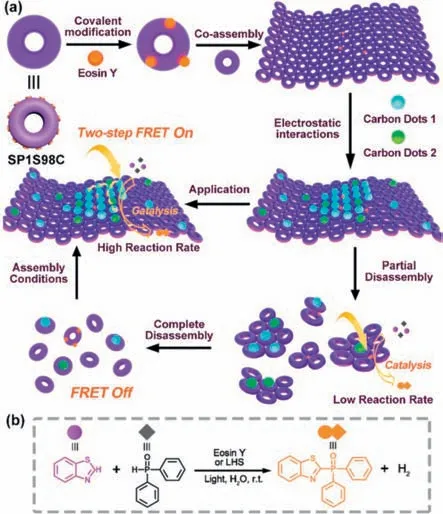
Fig.13.(a) Schematic illustration of the fabrication of the LHS with sequential energy transfer process and the control of the “On/Off” state of the FRET Process;(b)chemical equation of the C-H phosphorylation reaction between benzothiazole and diphenyl-phosphine.Reproduced with permission [87].Copyright 2022,American Chemical Society.
Carbon dots (CDs) are new fluorescent materials with outstanding photophysical properties.The authors synthesized two types of amino-abundant CDs (CD1 and CD2) with appropriate photophysical properties,both of which were introduced into the protein nanosheet systemviaelectrostatic interactions.Herein,CD1 with a diameter of 5.3 nm acts as an energy donor (D) and CD2 with a diameter of 4.9 nm serves as the first energy acceptor (A1).A second acceptor ESY (A2) was pre-attached onto the SP1 scaffolds to accept energy from CD2.The concentrated energy on ESY could be used for the photocatalysis of a model cross-coupling hydrogen evolution reaction (Fig.13b).It is noteworthy that excess reductant agent could disassemble the nanosheet and inhibit the LHS function.After fully removing reductants and reconstructing the system,the LHS function was recovered.Therefore,this system could be switched between assembly and disassembly,leading to an “On/Off” switchable sequential LHS.This work provides further insight into the exploration and fabrication of smart biomimetic photosystems.
5.Sequential LHSs based on other supramolecular scaffolds
In addition to the various non-covalent scaffolds discussed above,some other scaffolds have also been used to construct sequential LHSs.For example,Ouyang and Liuet al.synthesized a supramolecular helical nanotube based on a cyanostilbeneappended glutamate compound (CG),which shows both circularly polarized luminescence (CPL) and supramolecular chirality (Fig.14)[88].By co-assembling two achiral acceptors,thioflavin T (ThT) and acridine orange (AO),within the nanotubes,the excitation energy from CG could be funneled to AO through ThT.Remarkably,the helical nanotube can also transfer its chirality to the acceptors,resulting in a sequentially amplified CPL.This study provides new insights into understanding energy transfer in chiral supramolecular LHSs.
In another study,Han,Wang,and Xinget al.employed polyelectrolyte as dye-supporting scaffold for two-step LHS [89].In detail,they synthesized a cyano-substitutedp-phenylenevinylene derivative (PPTA) as donor,which could self-assemble into positively charged nanoparticles in water.Next,they loaded PPTA and two acceptors ESY and NiR into the carboxylic acid-modified anionic polyelectrolyte material guar gum (GP5A) to prepare artificial sequential LHS through electrostatic and van der Waals interactions,which can be used for photocatalysis of alkylation of C–H bonds of phenyl vinyl sulfone and THF.
Supramolecular polymers are dynamic monomeric arrays selfassembled from building blocks through non-covalent interactions.Supramolecular polymerization can not only bring together the monomeric fluorescent chromophores but also greatly enhance their fluorescence if the monomers are AIE active.Based on our experiences on ureidopyrimidinone (UPy)-based quadruple hydrogen bonding (QHB) interaction [90–93],we developed an artificial LHS based on a H-bonded supramolecular polymer in 2020[94].In this system,a TPE-bridged ditopic UPy monomerMwas used as the energy donor and NiR served as the energy acceptor.In the next year,we continued to useMas donor to fabricate a stepwise LHS by using two fluorescent dyes,DBT and NDI,as relay and final acceptors,respectively (Fig.15) [95].Mbased supramolecular polymeric nanoparticles (SPNPs) could be constructedviaa mini-emulsion method in water with the assistance of cetyltrimethyl ammonium bromide (CTAB),resulting in a bright cyan fluorescence.The QHB interaction plays a dual role:putting the monomers together and enhancing the AIE effect.This sequential LHS shows an overall antenna effect (AE) up to 63 under a very high D/A ratio (M/DBT/NDI=1250/25/1).This energy transfer cascade based on SPNPs shows great potential in mimicking photosynthesis and developing tunable fluorescent nanomaterials.

Fig.15.Schematic representation of the fabrication of a two-step energy-transfer LHS and the chemical structures of M,DBT,NDI,and the UPy dimer.Reproduced with permission [95].Copyright 2021,the Royal Society of Chemistry.
Manually built systems for sequential energy transfer and chirality amplification have attracted considerable attention.However,the construction of chiral supramolecular LHSs remains a big challenge [88].In a recent work,Zheng and Zanget al.developed new chiral LHSs with a sequential FRET process where a blue-violetemitting BINOL compound (BDA) serves as an initiator of chirality and light antenna (Fig.16) [96].Moreover,a hexagonal TPE-based macrocycle (TPEM) with AIE effect acts as an energy relay,and NiR or TPESe serve as the final acceptors.As a result,triad sequential LHS was successfully realized with interesting chirality transmission/amplification along the cascade BDA-TPEM-NiR or BDA-TPEMTPESe,producing bright tailored-color CPL and white-light emission with an amplified glumof 3.5×10-2.This study opens a new window to mimic the chiral LHS in nature and exhibits potential applications in CPL-related fields,such as CPL switches,CP-OLEDs and optical encryption.

Fig.16.(a) Synthesis of hexagonal [3+3] macrocycle TPEM and (b) schematic illustration of the process of chiral light-harvesting and full-color CPL.Reproduced with permission [96].Copyright 2022,American Chemical Society.
6.Conclusions
In summary,developments in the fabrication of lightharvesting systems with two-step sequential energy transfer based on supramolecular self-assembly are reviewed.A diverse range of self-assembled scaffolds,such as host-guest assemblies,metal-coordination assemblies,bio-macromolecular assemblies,supramolecular polymers,as well as helical nanotubes,have been employed to construct artificial sequential LHSs.Light-harvesting antennas/excitation energy donor and energy acceptors can be incorporated/self-assembled into these scaffolds,providing great convenience for FRET between them,leading to high sequential energy transfer efficiency and antenna effect.Overall,to build an efficient supramolecular two-step LHSs,three aspects need to be considered: (1) wavelength matching between the donor and the first acceptor,as well as the first acceptor and the second acceptor should be guaranteed for efficient FRET;(2) the acceptor dyes should be surrounded by a large number of antenna fluorophores(donor);(3) these donor and acceptor molecules should be densely packed in a confined space but ACQ effect should be avoided.
These supramolecular LHSs not only provide an ideal model to mimic multi-step energy transfer in natural photosynthesis,but also demonstrate great potentials in many application fields,including tunable emissive materials,photocatalysis,and information encryptionetc.Although a series of progress has been made in supramolecular sequential LHS in the past three years,there are still several issues that need to be paid attention to in future development: (1) in order to meet the requirement of real-life application,the construction of sequential LHSs with long-term stability is particularly necessary;(2) considering that photosynthesis occurs in the green leaves of plants in nature,it is highly desirable to develop sequential LHSs in the solid state,such as films,hydrogels,etc.;(3) this minireview mainly focuses on two-step energy transfer system,so the construction of a three-step energy transfer system is more challenging and is one of the directions of future efforts.Overall,we believe that these described cases are not an exhaustive list.In the future,more and more sequential LHSs with multifunctionality will be developed,and the field as a whole has a “colorful” prospect,as gorgeous as the material itself.
Declaration of competing interest
The authors declare that they have no known competing financial interests or personal relationships that could have appeared to influence the work reported in this paper.
Acknowledgment
Financial support from the National Natural Science Foundation of China (No.21702020) is gratefully acknowledged.
 Chinese Chemical Letters2024年1期
Chinese Chemical Letters2024年1期
- Chinese Chemical Letters的其它文章
- Spin switching in corrole radical complex
- Benzothiadiazole-based materials for organic solar cells
- Mono-functionalized pillar[n]arenes: Syntheses,host–guest properties and applications✰
- From oxygenated monomers to well-defined low-carbon polymers
- Doping-induced charge transfer in conductive polymers
- Quinoline-based anti-MRSA agents: Current development,structure-activity relationships,and mechanisms
